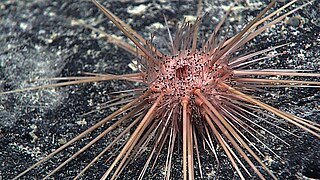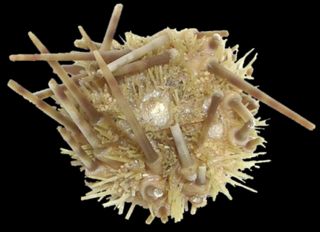Anametalia grandis is a species of sea urchin of the family Brissidae. Their armour is covered with spines. It is placed in the genus Anametalia and lives in the sea. Anametalia grandis was first scientifically described in 1950 by Ole Mortensen.
Anametalia regularis is a species of sea urchin of the family Brissidae. Their armour is covered with spines. It is placed in the genus Anametalia and lives in the sea. Anametalia regularis was first scientifically described in 1925 by Hubert Clark.
Anametalia sternaloides is a species of sea urchin of the family Brissidae. Their armour is covered with spines. It is placed in the genus Anametalia and lives in the sea. Anametalia sternaloides was first scientifically described in 1874 by Bolau.
Anochanus sinensis is a species of sea urchin of the family Cassiduloida. Their armour is covered with spines. It is placed in the genus Anochanus and lives in the sea. Anochanus sinensis was first scientifically described in 1868 by Adolph Grube.
Caenopedina alanbakeri is a species of sea urchins of the Family Pedinidae. Their armour is covered with spines. Caenopedina alanbakeri was first scientifically described in 1989 by Rowe.
Caenopedina annulata is a species of sea urchins of the Family Pedinidae. Their armour is covered with spines. Caenopedina annulata was first scientifically described in 1940 by Ole Theodor Jensen Mortensen.
Caenopedina capensis is a species of sea urchins of the Family Pedinidae. Their armour is covered with spines. Caenopedina capensis was first scientifically described in 1923 by Hubert Lyman Clark.
Caenopedina cubensis is a species of sea urchins of the Family Pedinidae. Their armor is covered with spines. Caenopedina cubensis was first scientifically described in 1869 by Alexander Emanuel Agassiz.
Caenopedina depressa is a species of sea urchins of the Family Pedinidae. Their armour is covered with spines. Caenopedina depressa was first scientifically described in 1927 by Koehler.
Caenopedina diomedeae is a species of sea urchins of the Family Pedinidae. Their armour is covered with spines. Caenopedina diomedeae was first scientifically described in 1939 by Ole Theodor Jensen Mortensen.

Caenopedina hawaiiensis is a species of sea urchins of the Family Pedinidae. Their armor is covered with spines. Caenopedina hawaiiensis was first scientifically described in 1912 by Hubert Lyman Clark.
Caenopedina indica is a species of sea urchins of the Family Pedinidae. Their armour is covered with spines. Caenopedina indica was first scientifically described in 1903 by de Meijere.

Caenopedina mirabilis is a species of sea urchins of the Family Pedinidae. Their armour is covered with spines. Caenopedina mirabilis was first scientifically described in 1885 by Döderlein.
Caenopedina novaezealandiae is a species of sea urchins of the Family Pedinidae. Their armour is covered with spines. Caenopedina novaezealandiae was first scientifically described in 1964 by Pawson.
Caenopedina otagoensis is a species of sea urchins of the Family Pedinidae. Their armour is covered with spines. Caenopedina otagoensis was first scientifically described in 1968 by McKnight.
Caenopedina porphyrogigas is a species of sea urchins of the Family Pedinidae. Their armour is covered with spines. Caenopedina porphyrogigas was first scientifically described in 2009 by Anderson.
Caenopedina pulchella is a species of sea urchins of the family Pedinidae. Their armour is covered with spines. Caenopedina pulchella was first scientifically described in 1907 by Alexander Emanuel Agassiz and Hubert Lyman Clark.
Calocidaris micans is a species of sea urchins of the Family Cidaridae. Their armour is covered with spines. Calocidaris micans was first scientifically described in 1903 by Ole Mortensen.
Chondrocidaris brevispina is a species of sea urchins of the Family Cidaridae. Their armour is covered with spines. Chondrocidaris brevispina was first scientifically described in 1925 by Hubert Lyman Clark.
Chondrocidaris is a genus of sea urchins of the family Cidaridae described in 1863 by Alexander Agassiz. There are two living species and several fossil species dating as far back as the Miocene.



